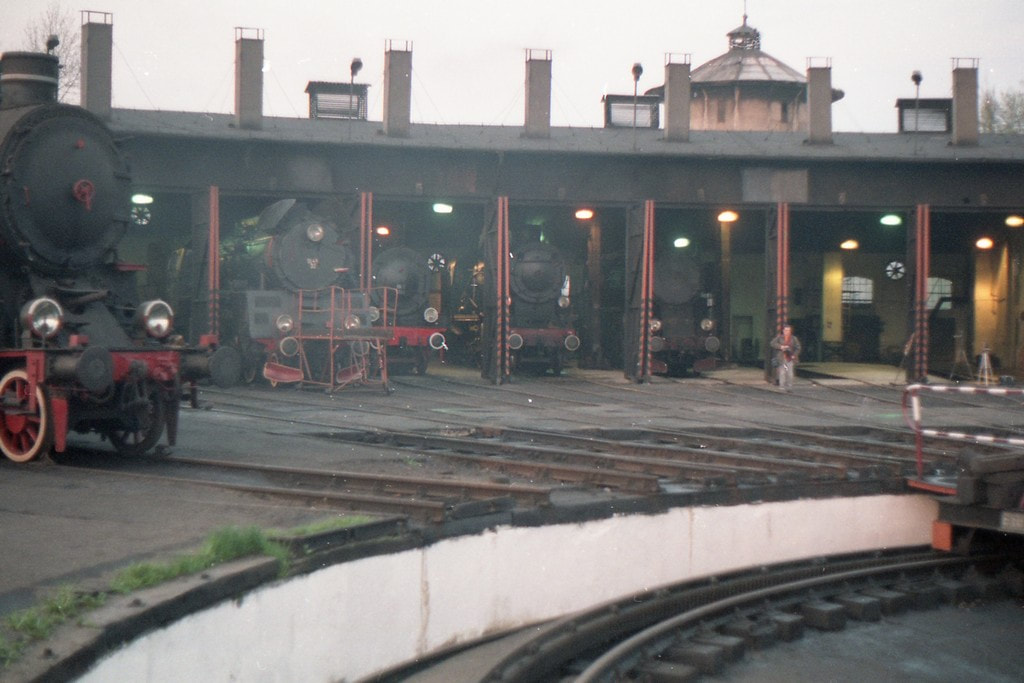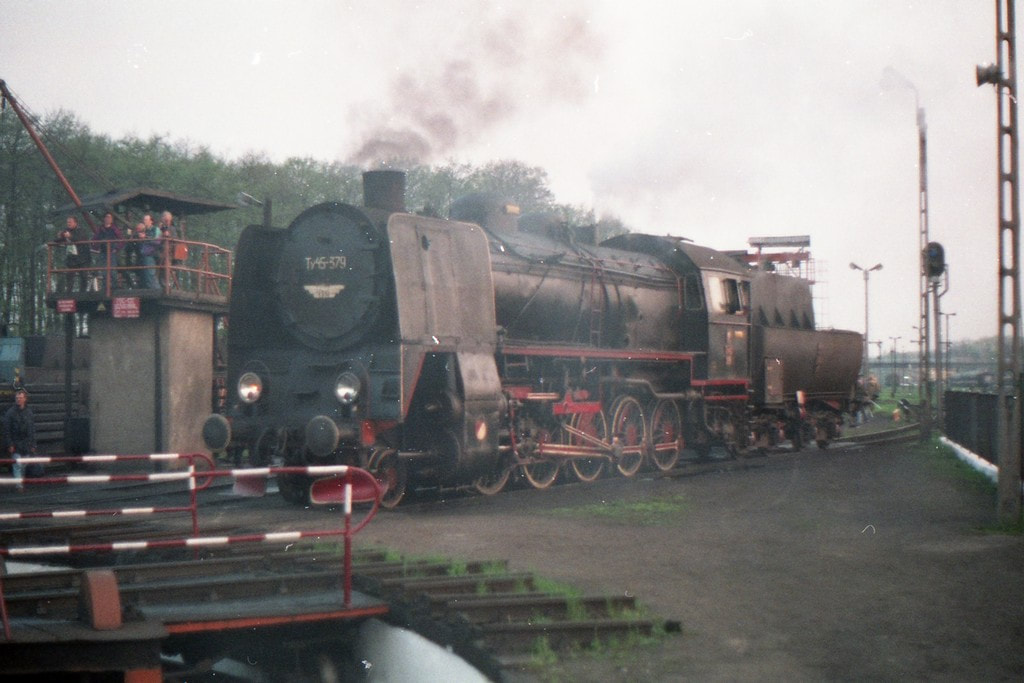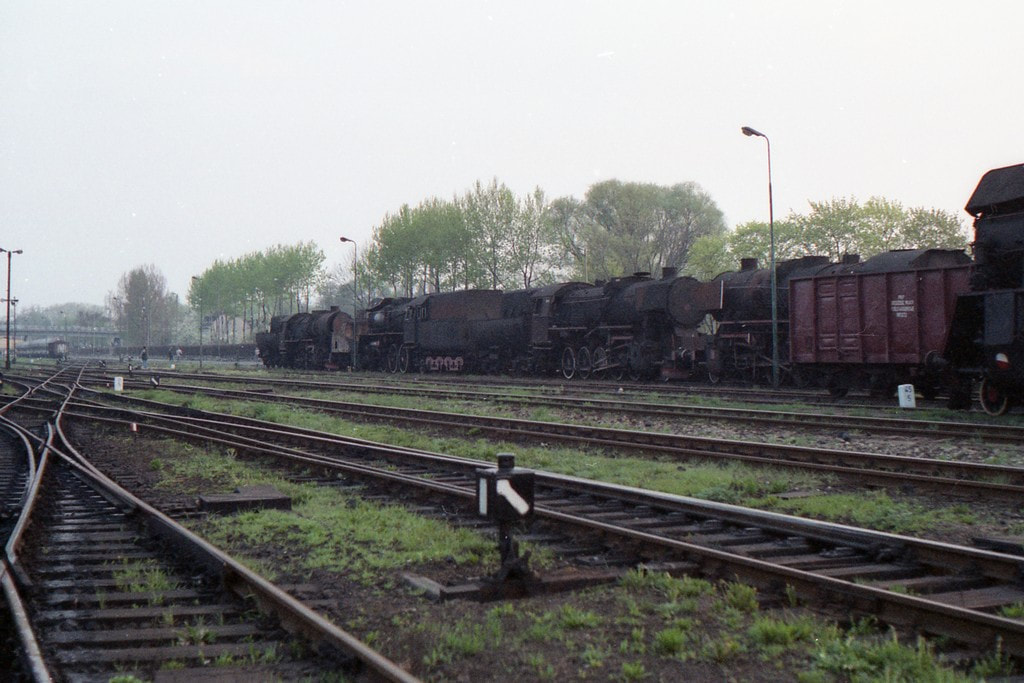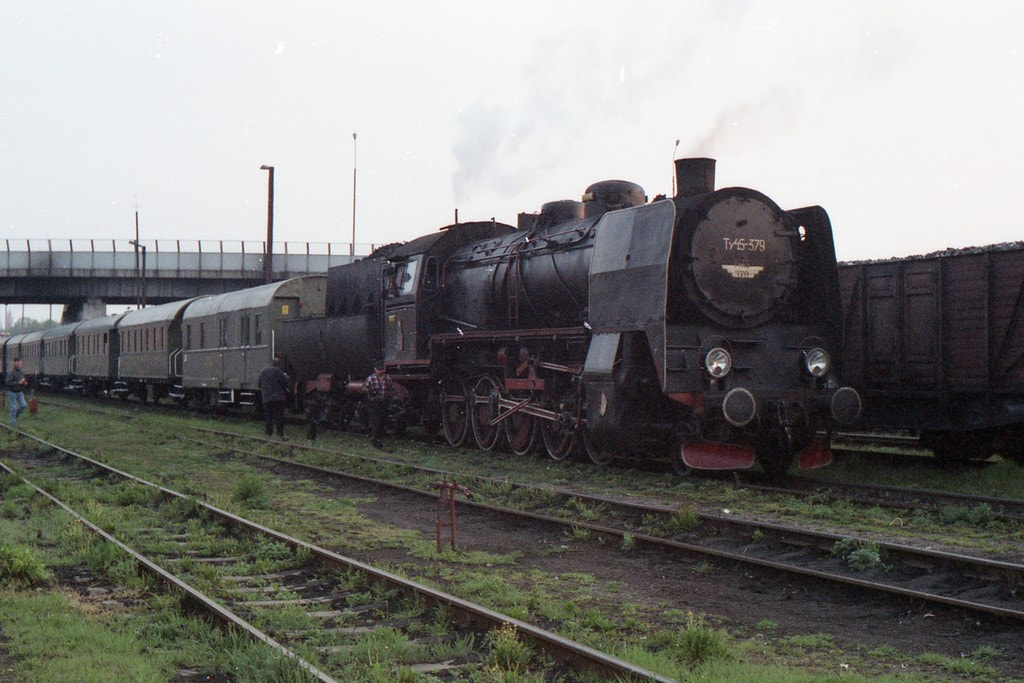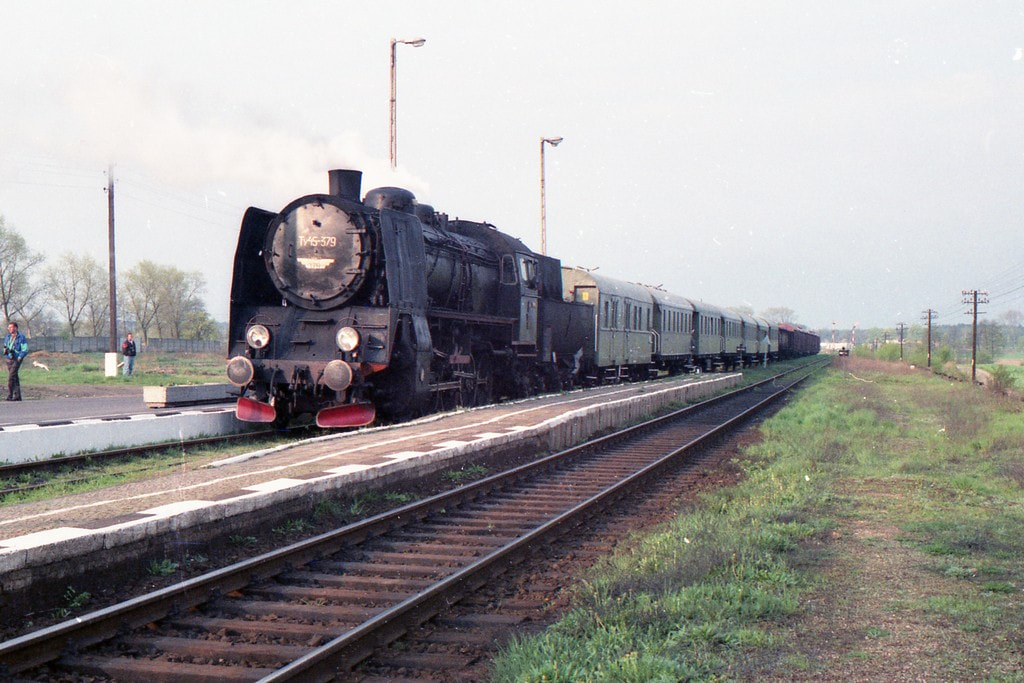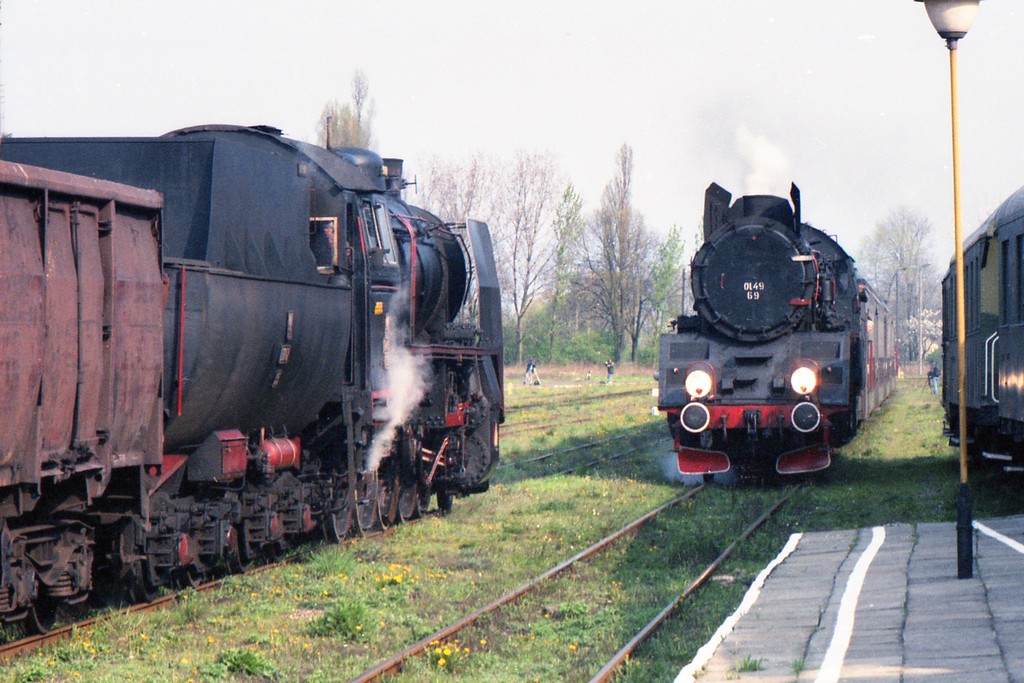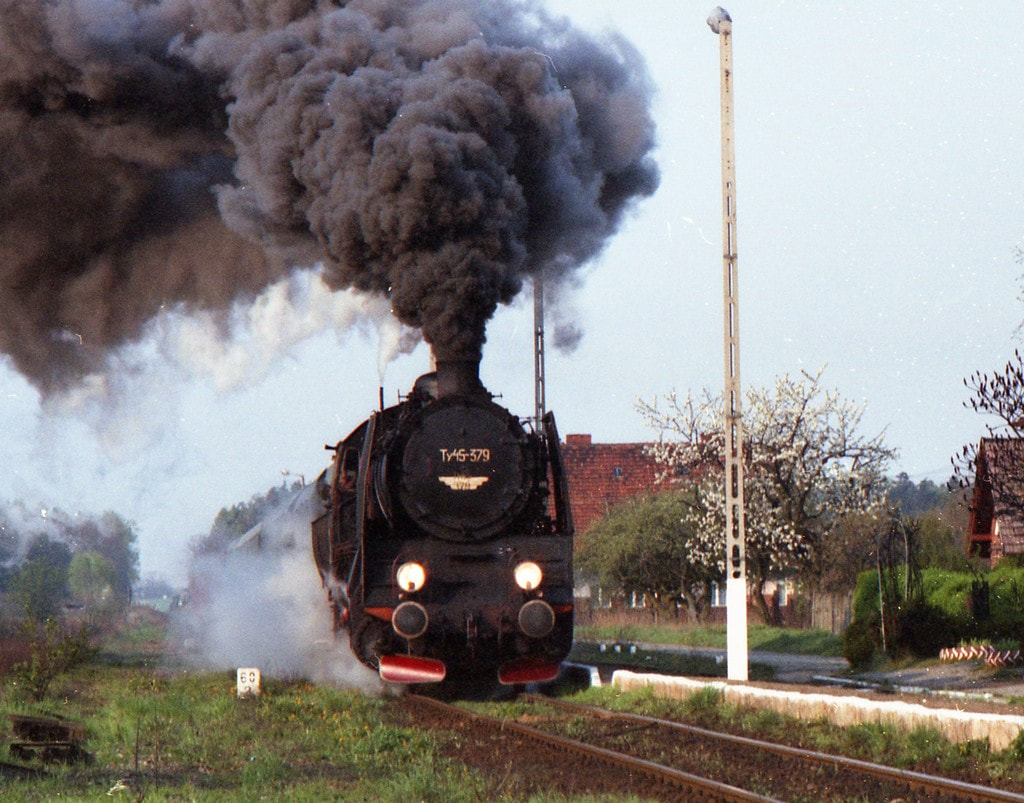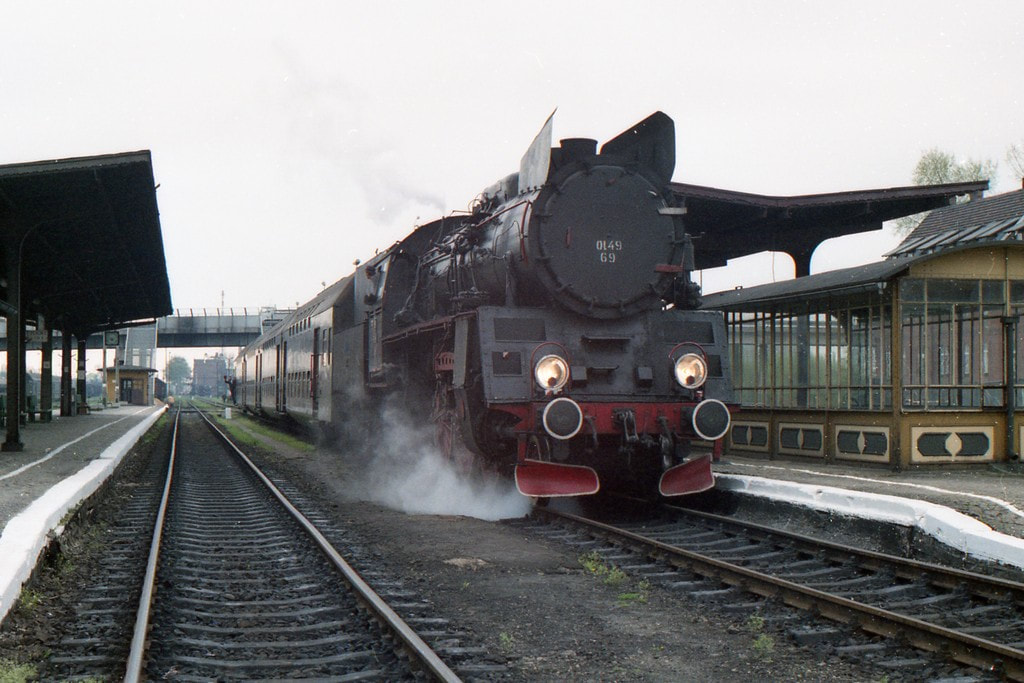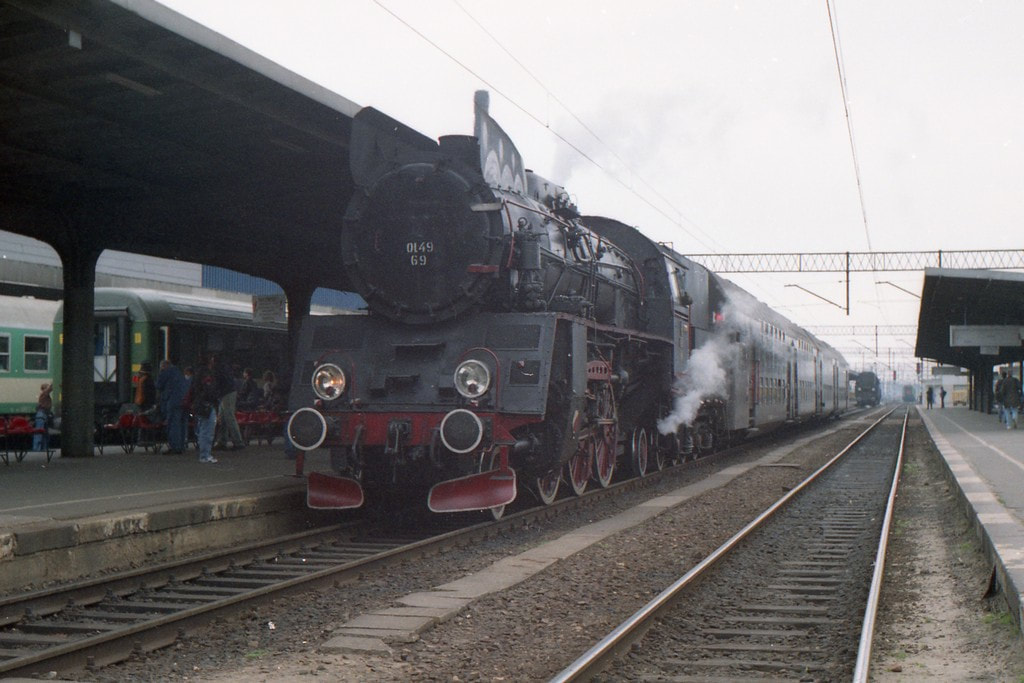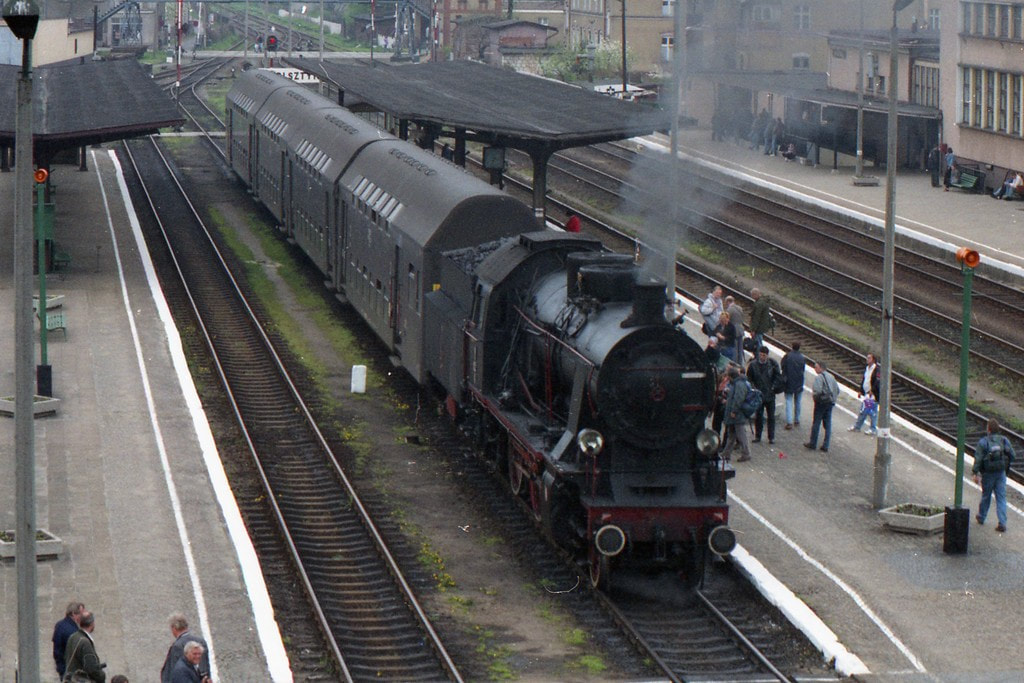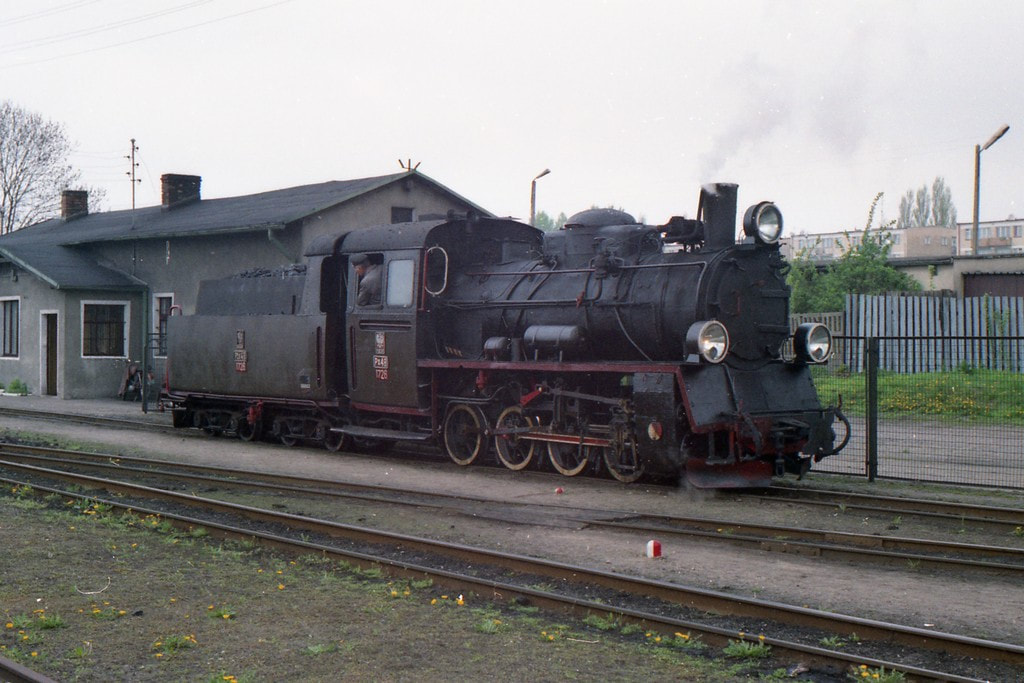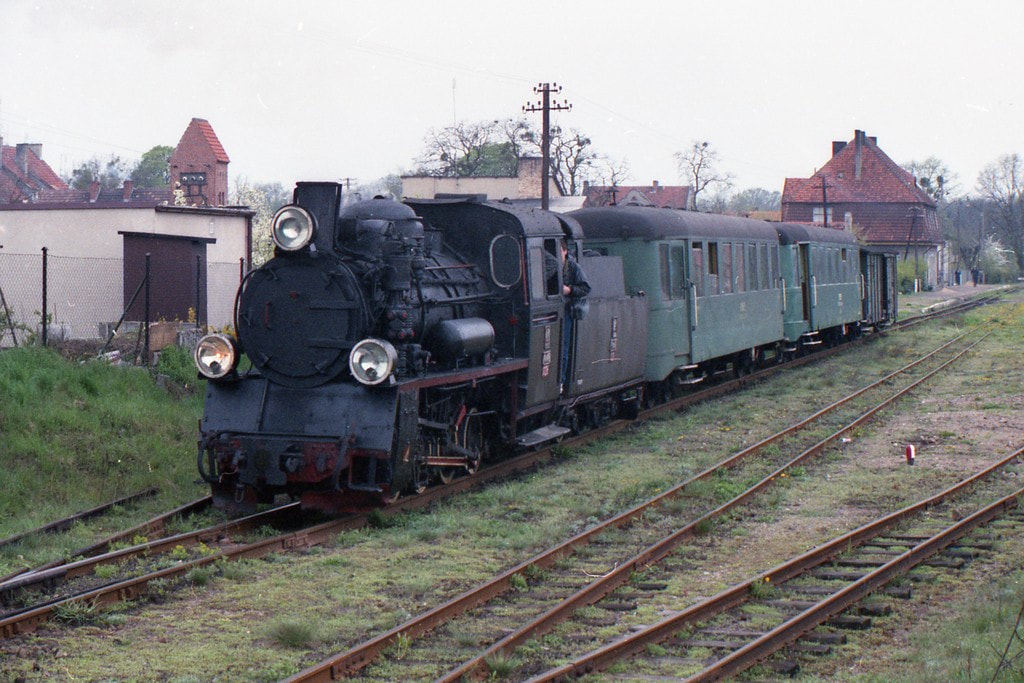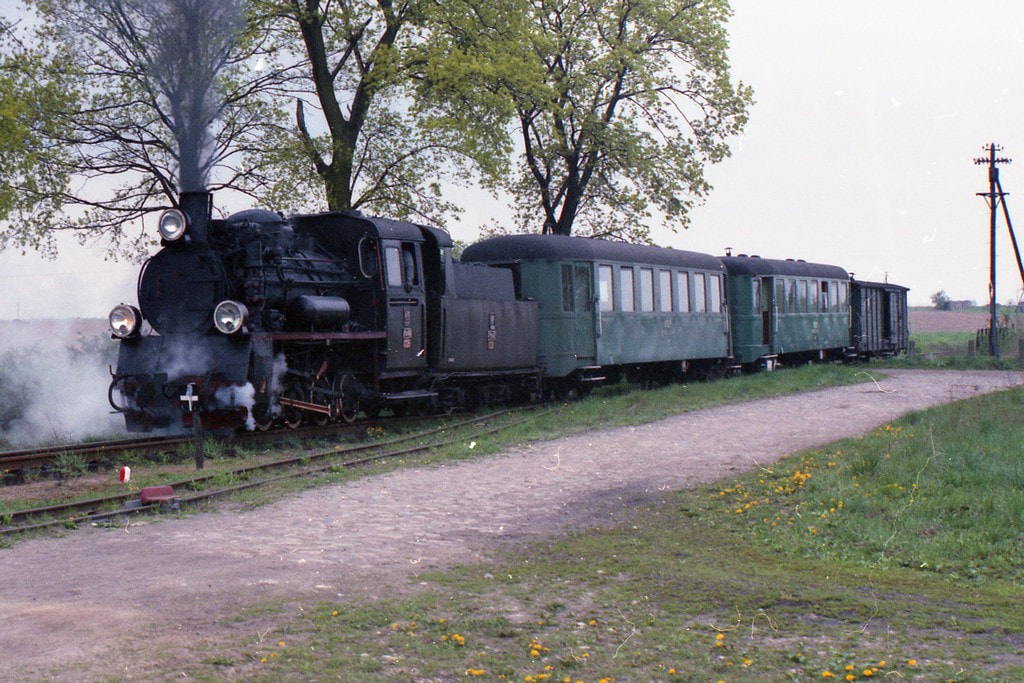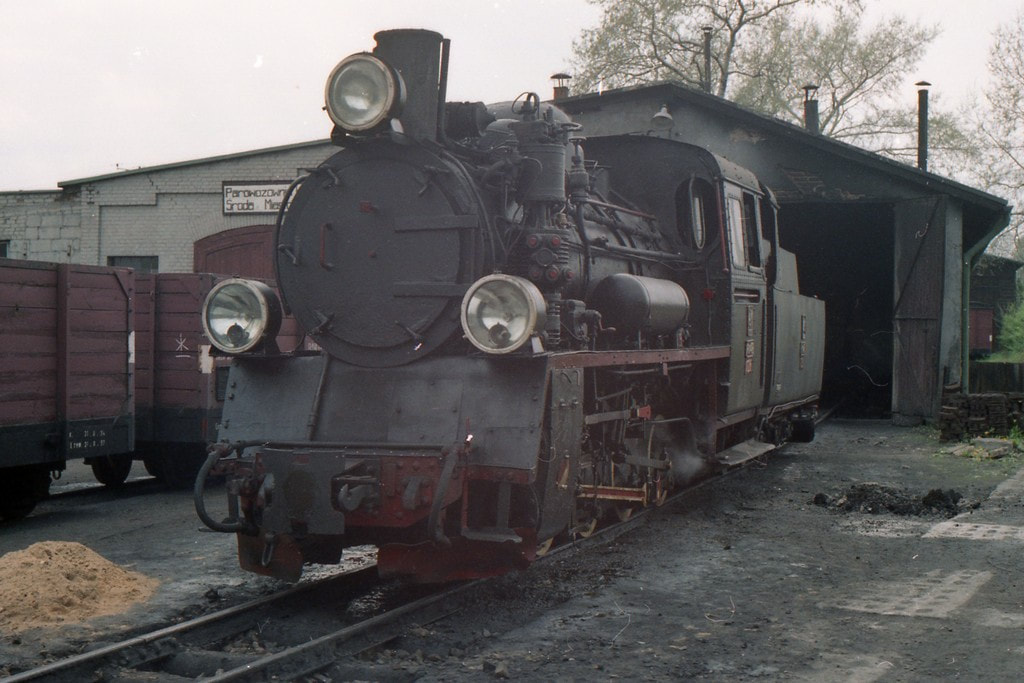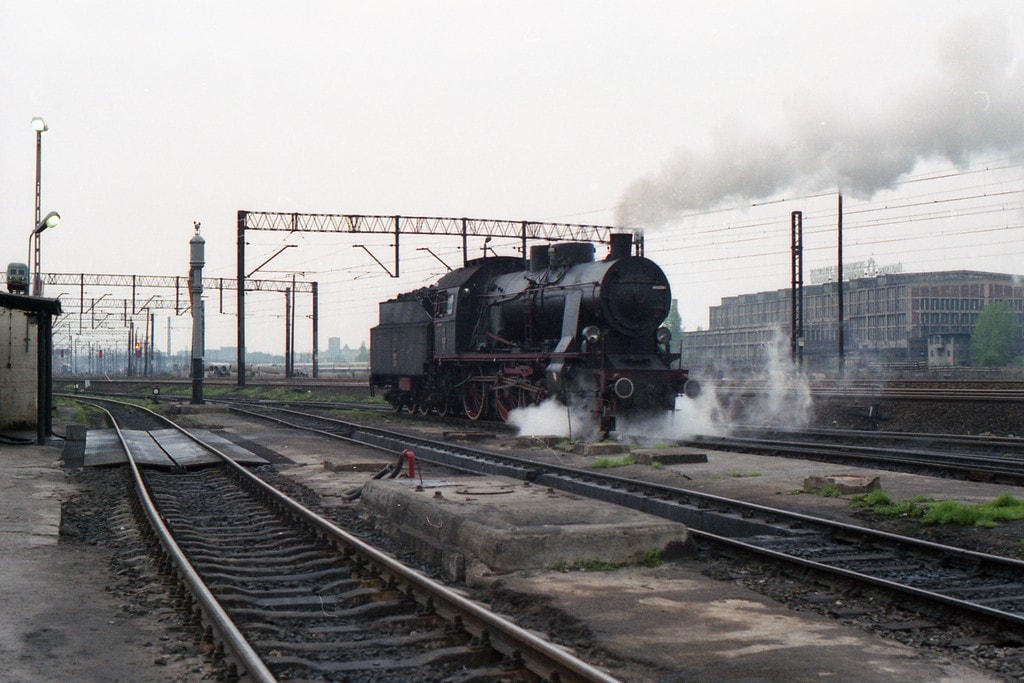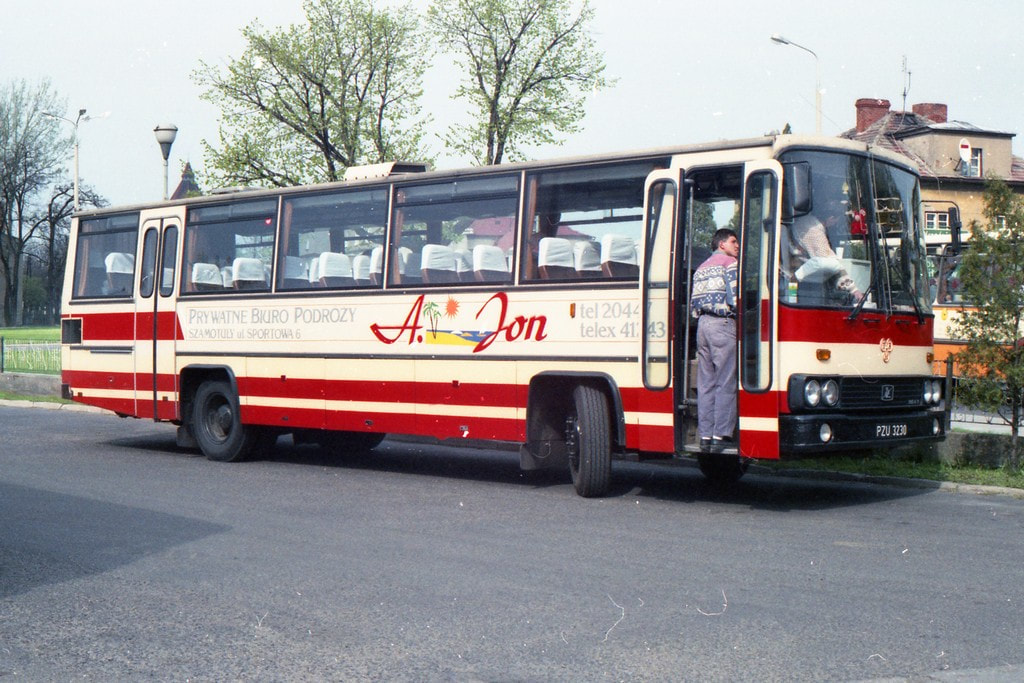This was another new venture for me (and although I enjoyed it) the only such trip I've ever done. Probably the trigger was the 'not done' Grodzisk-Wolsztyn stretch which I hadn't had time to do in 1993. That's my story, anyway, and I'm sticking to it.
This new venture was a Steam Railway-organised venture to Wolsztyn for steam operation on what was then (and still is, if the winding down of the Wolsztyn Experience hasn't killed it off) the last regular steam hauled passenger service in Europe. I hadn't ever done such a bash before so wasn't entirely sure what to expect. Although by now I'd got used to organising my own travels around the easier bits of Europe it was a change to have somebody else doing it!
Thursday 27 April 1995
A late night charter flight from Gatwick to Poznań followed by a 70km coach journey from Poznań airport got us to Wolsztyn at really stupid o'clock - 04:something, from 30-years-ago-half-asleep memory. It being, of course, really dark, I'd need a tripod at the very least if I wanted any photos. Pity I hadn't brought one - either I hadn't been told about the night session (unlikely) or simply hadn't got my brain organised when preparing for the trip (far more likely, as it was a bit outside my run-of-the-mill railway activities). Be that as it may, photography - never my strong point - wasn't really going to be a success and so it proved with the only four photos I took before the sun put in an appearance around 06:00. That said, after my very late in life start on any sort of rail travel outside the UK it was an interesting experience to be wandering unchecked around a proper working steam shed in an unfamiliar country during the night, so the opportunity wasn't wasted.
Once the sun had started to put in an appearance we were able to see 2-10-0 Ty45 379 making its way off the turntable and preparing our 'charter train' consisting some very antiquated coaches marshalled in front of a string of wagons, so I suspected just a change of a booked freight into a mixed. This was borne out at Grodzisk later on when the coaches were dropped off, presumably for collection by the Ty45 on its way back to Wolsztyn, and the wagons took up position behind the Ty45. We set off on the 'mixed' after viewing the arrival of - shock, horror - a diesel (1700hp Co-Co SU45-254) with an early morning working from Leszno. En route we paused at Rakoniewice to cross the inbound diesel worked hauled 06:00 ex Poznań. A photo stop was made at Ruchocice, the opportunity being taken for much photography, and a notably volcanic run-past by Ty45-379. Goodness knows what they'd had in the tender ready for that.
Onwards then to Grodzisk, where the 'mixed' was converted to a freight as already noted, and we joined the 07:50 from Poznań Glówny, hauled by 2-6-2 Ol49-69. This being a booked passenger turn we had no more distractions on the way back to Wolsztyn. There followed a couple of hours' break, which judging by my various photos of Wolsztyn's town centre, provided a breakfast opportunity as well.
We were back with Ol49-69 on the 11:15 departure to Poznań Glówny which again was a booked passenger turn, stopping at all stations. The operating here was very brisk, with Ol49-7 already backing down on to the rear of the train before Ol49-69 had uncoupled and gone off to the shed. Ol49-7 took us back to Wolsztyn on the 13:40 departure from Poznań Glówny and there we found Ok22-31, a Polish-built 4-6-0 based on the design of the well known Prussian P8, being prepared for the 15:44 departure. I'm not sure if we returned to Poznań Glówny on that service - I suspect we would have done, for our fourth steam loco for haulage - I have a photo of Ty45-379 and Ol49-7 on Wolsztyn shed taken after the ones of the Ok22 but I'm almost sure they were taken from a passing train, and a steam hauled one at that. It does make sense, as we ended up for the night in Poznań at the Hotel Polonez.
Thursday 27 April 1995
A late night charter flight from Gatwick to Poznań followed by a 70km coach journey from Poznań airport got us to Wolsztyn at really stupid o'clock - 04:something, from 30-years-ago-half-asleep memory. It being, of course, really dark, I'd need a tripod at the very least if I wanted any photos. Pity I hadn't brought one - either I hadn't been told about the night session (unlikely) or simply hadn't got my brain organised when preparing for the trip (far more likely, as it was a bit outside my run-of-the-mill railway activities). Be that as it may, photography - never my strong point - wasn't really going to be a success and so it proved with the only four photos I took before the sun put in an appearance around 06:00. That said, after my very late in life start on any sort of rail travel outside the UK it was an interesting experience to be wandering unchecked around a proper working steam shed in an unfamiliar country during the night, so the opportunity wasn't wasted.
Once the sun had started to put in an appearance we were able to see 2-10-0 Ty45 379 making its way off the turntable and preparing our 'charter train' consisting some very antiquated coaches marshalled in front of a string of wagons, so I suspected just a change of a booked freight into a mixed. This was borne out at Grodzisk later on when the coaches were dropped off, presumably for collection by the Ty45 on its way back to Wolsztyn, and the wagons took up position behind the Ty45. We set off on the 'mixed' after viewing the arrival of - shock, horror - a diesel (1700hp Co-Co SU45-254) with an early morning working from Leszno. En route we paused at Rakoniewice to cross the inbound diesel worked hauled 06:00 ex Poznań. A photo stop was made at Ruchocice, the opportunity being taken for much photography, and a notably volcanic run-past by Ty45-379. Goodness knows what they'd had in the tender ready for that.
Onwards then to Grodzisk, where the 'mixed' was converted to a freight as already noted, and we joined the 07:50 from Poznań Glówny, hauled by 2-6-2 Ol49-69. This being a booked passenger turn we had no more distractions on the way back to Wolsztyn. There followed a couple of hours' break, which judging by my various photos of Wolsztyn's town centre, provided a breakfast opportunity as well.
We were back with Ol49-69 on the 11:15 departure to Poznań Glówny which again was a booked passenger turn, stopping at all stations. The operating here was very brisk, with Ol49-7 already backing down on to the rear of the train before Ol49-69 had uncoupled and gone off to the shed. Ol49-7 took us back to Wolsztyn on the 13:40 departure from Poznań Glówny and there we found Ok22-31, a Polish-built 4-6-0 based on the design of the well known Prussian P8, being prepared for the 15:44 departure. I'm not sure if we returned to Poznań Glówny on that service - I suspect we would have done, for our fourth steam loco for haulage - I have a photo of Ty45-379 and Ol49-7 on Wolsztyn shed taken after the ones of the Ok22 but I'm almost sure they were taken from a passing train, and a steam hauled one at that. It does make sense, as we ended up for the night in Poznań at the Hotel Polonez.
Friday 28 April 1995
The main target for today was the 750mm gauge line, at that time still a steam-worked PKP operation, from Środa Miasto to Zaniemysl. It's only about 800 metres from Środa's main line station to Środa Miasto, the narrow gauge station, but for whatever reason we travelled by coach there and back. This time we did have a charter train on this delightful ('bucolic' might even apply) branch line, just over 14km long. It had quite a sparse public service and its antiquated equipment, uncomfortable riding and poor track would have done it no favours against the 11km bus journey. PKP closed it, unsurprisingly, from 8 June 2001 but the line was resurrected as a preservation operation in 2003 and remains in operation at weekends May-September as a tourist line.
The round trip including runpasts and photo stops, with ample time for looking over Środa Miasto's station and shed occupied several hours. With no indication of any modernisation since WWII (well, maybe a bit - the Px48 locos date from the early 1950s but were developed from a 1929 design) the whole setup was (cliché alert) a time capsule. Sufficiently wonderful that I went back on my own the next year, but that's another story.
The operational loco on the day was 0-8-0 Px48-1726, with a train of two bogie coaches and a wooden bodied guard's van. There was a spare loco in the shed; I didn't note its number but perhaps it was Px48-1728, the one which works the line today. There was a third loco outside which looked as if it might have steamed its last.
We were back at Poznań in time to photograph Ol49-7 arriving with the 15:44 train from Wolsztyn; also Ok22-31 was present when we visited the shed. The arrangements for the evening were modified somewhat, as our flight back to the UK was delayed - but we did get to travel behind Ol49-7 on a service train, in the dark. The stop at each station en route allowed an ad hoc arrangement whereby between each two stops a small group were able to ride on the footplate, thus getting a good number of us a cab ride. I've had a few cab rides on steam locos over the years, but that evening on the Ol-49 in the dark, even just for a few minutes, has stayed with me the most - and as it's done so for nearly 30 years, then 'I'll never forget it' might not be too rash a statement.
Of the journey home, I remember absolutely nothing but it was probably fairly tiring given that we didn't leave Poland until very late evening, probably near midnight.
The main target for today was the 750mm gauge line, at that time still a steam-worked PKP operation, from Środa Miasto to Zaniemysl. It's only about 800 metres from Środa's main line station to Środa Miasto, the narrow gauge station, but for whatever reason we travelled by coach there and back. This time we did have a charter train on this delightful ('bucolic' might even apply) branch line, just over 14km long. It had quite a sparse public service and its antiquated equipment, uncomfortable riding and poor track would have done it no favours against the 11km bus journey. PKP closed it, unsurprisingly, from 8 June 2001 but the line was resurrected as a preservation operation in 2003 and remains in operation at weekends May-September as a tourist line.
The round trip including runpasts and photo stops, with ample time for looking over Środa Miasto's station and shed occupied several hours. With no indication of any modernisation since WWII (well, maybe a bit - the Px48 locos date from the early 1950s but were developed from a 1929 design) the whole setup was (cliché alert) a time capsule. Sufficiently wonderful that I went back on my own the next year, but that's another story.
The operational loco on the day was 0-8-0 Px48-1726, with a train of two bogie coaches and a wooden bodied guard's van. There was a spare loco in the shed; I didn't note its number but perhaps it was Px48-1728, the one which works the line today. There was a third loco outside which looked as if it might have steamed its last.
We were back at Poznań in time to photograph Ol49-7 arriving with the 15:44 train from Wolsztyn; also Ok22-31 was present when we visited the shed. The arrangements for the evening were modified somewhat, as our flight back to the UK was delayed - but we did get to travel behind Ol49-7 on a service train, in the dark. The stop at each station en route allowed an ad hoc arrangement whereby between each two stops a small group were able to ride on the footplate, thus getting a good number of us a cab ride. I've had a few cab rides on steam locos over the years, but that evening on the Ol-49 in the dark, even just for a few minutes, has stayed with me the most - and as it's done so for nearly 30 years, then 'I'll never forget it' might not be too rash a statement.
Of the journey home, I remember absolutely nothing but it was probably fairly tiring given that we didn't leave Poland until very late evening, probably near midnight.
Later in May 1995 the BLS and their very capable organiser CT came up with the Double Dutch Docker tour, and that provided a convenient peg on which to hang another visit to The Netherlands.
